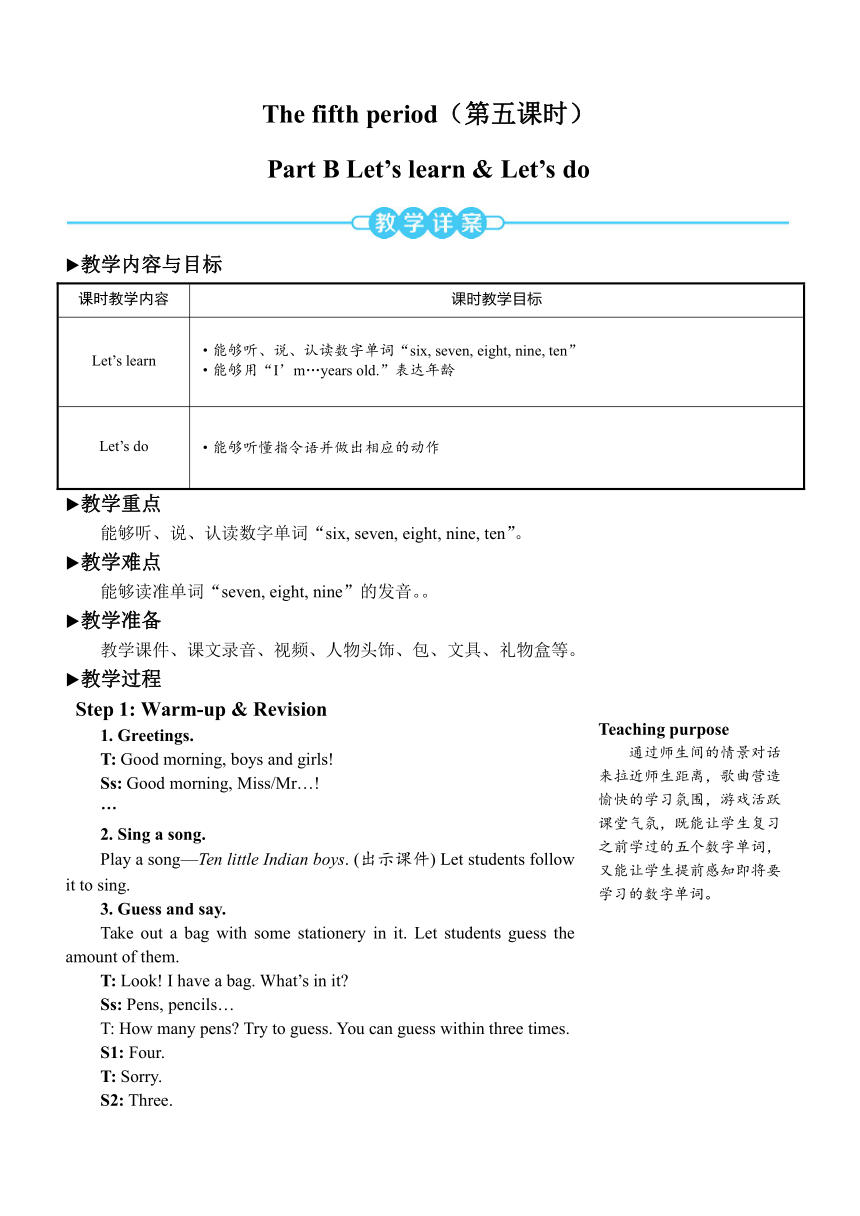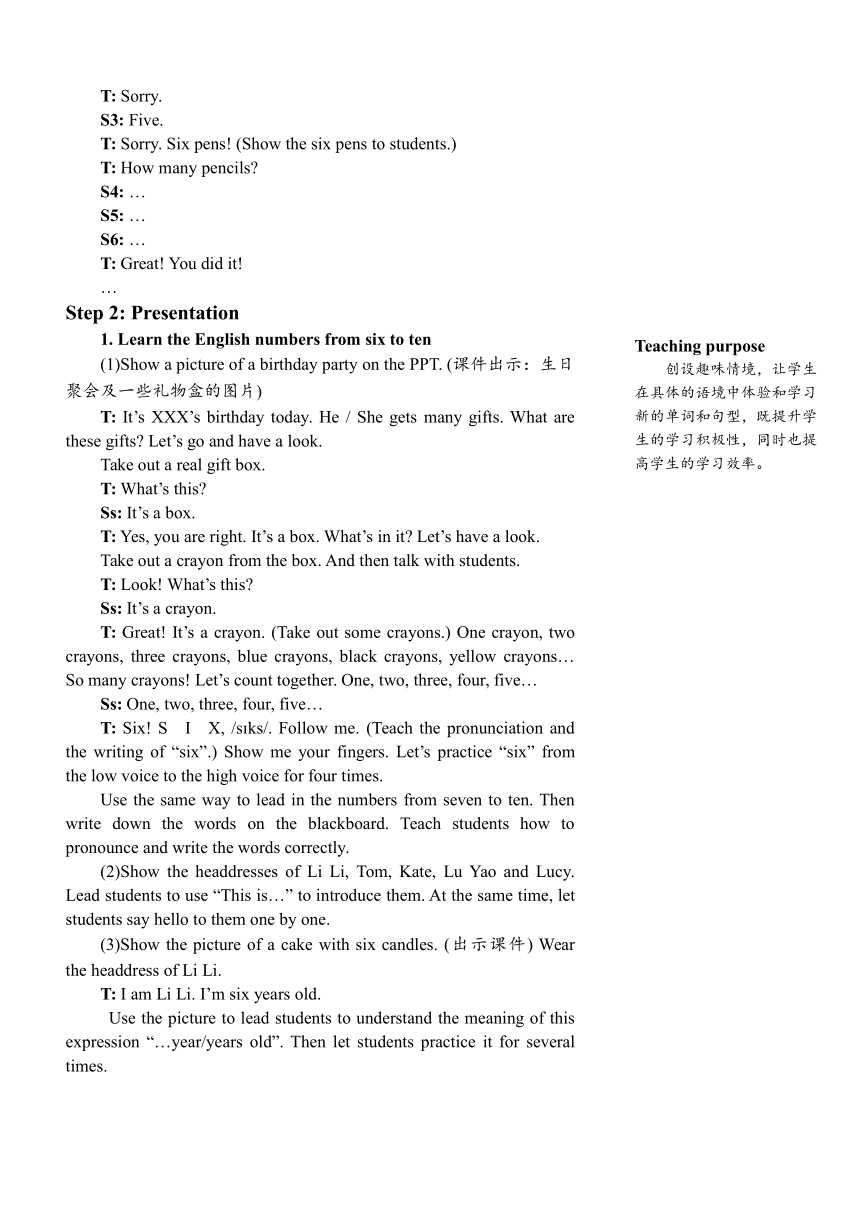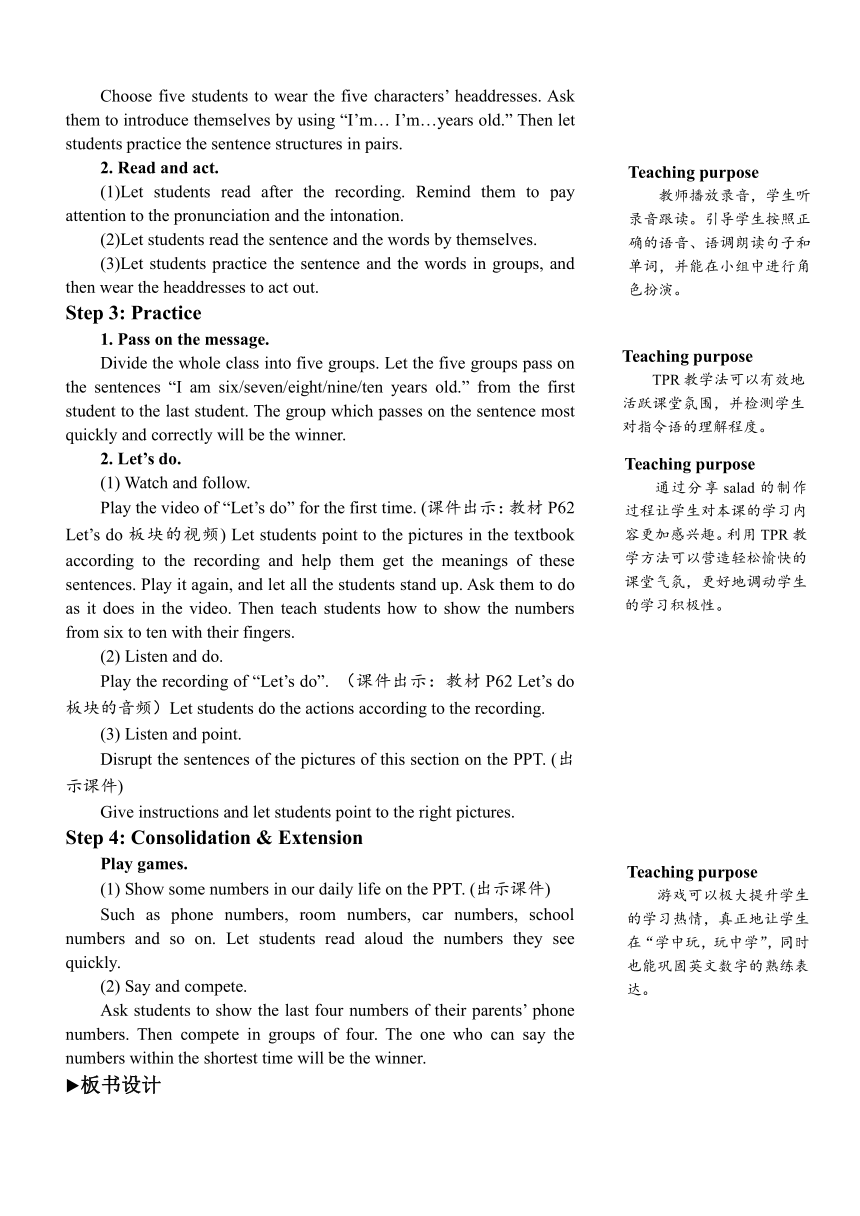Unit 6 Happy birthday! Part B Let’s learn教案(含反思,详案与简案)
文档属性
| 名称 | Unit 6 Happy birthday! Part B Let’s learn教案(含反思,详案与简案) |  | |
| 格式 | zip | ||
| 文件大小 | 102.4KB | ||
| 资源类型 | 教案 | ||
| 版本资源 | 人教版(PEP) | ||
| 科目 | 英语 | ||
| 更新时间 | 2020-07-10 11:27:47 | ||
图片预览



文档简介
The
fifth
period(第五课时)
Part
B
Let’s
learn
&
Let’s
do
?教学内容与目标
课时教学内容
课时教学目标
Let’s
learn
·能够听、说、认读数字单词“six,
seven,
eight,
nine,
ten”·能够用“I’m…years
old.”表达年龄
Let’s
do
·能够听懂指令语并做出相应的动作
?教学重点
能够听、说、认读数字单词“six,
seven,
eight,
nine,
ten”。
?教学难点
能够读准单词“seven,
eight,
nine”的发音。。
?教学准备
教学课件、课文录音、视频、人物头饰、包、文具、礼物盒等。
?教学过程
Step
1:
Warm-up
&
Revision
1.
Greetings.
T:
Good
morning,
boys
and
girls!
Ss:
Good
morning,
Miss/Mr…!
…
2.
Sing
a
song.
Play
a
song—Ten
little
Indian
boys.
(出示课件)
Let
students
follow
it
to
sing.
3.
Guess
and
say.
Take
out
a
bag
with
some
stationery
in
it.
Let
students
guess
the
amount
of
them.
T:
Look!
I
have
a
bag.
What’s
in
it?
Ss:
Pens,
pencils…
T:
How
many
pens?
Try
to
guess.
You
can
guess
within
three
times.
S1:
Four.
T:
Sorry.
S2:
Three.
T:
Sorry.
S3:
Five.
T:
Sorry.
Six
pens!
(Show
the
six
pens
to
students.)
T:
How
many
pencils?
S4:
…
S5:
…
S6:
…
T:
Great!
You
did
it!
…
Step
2:
Presentation
1.
Learn
the
English
numbers
from
six
to
ten
(1)Show
a
picture
of
a
birthday
party
on
the
PPT.
(课件出示:生日聚会及一些礼物盒的图片)
T:
It’s
XXX’s
birthday
today.
He
/
She
gets
many
gifts.
What
are
these
gifts?
Let’s
go
and
have
a
look.
Take
out
a
real
gift
box.
T:
What’s
this?
Ss:
It’s
a
box.
T:
Yes,
you
are
right.
It’s
a
box.
What’s
in
it?
Let’s
have
a
look.
Take
out
a
crayon
from
the
box.
And
then
talk
with
students.
T:
Look!
What’s
this?
Ss:
It’s
a
crayon.
T:
Great!
It’s
a
crayon.
(Take
out
some
crayons.)
One
crayon,
two
crayons,
three
crayons,
blue
crayons,
black
crayons,
yellow
crayons…
So
many
crayons!
Let’s
count
together.
One,
two,
three,
four,
five…
Ss:
One,
two,
three,
four,
five…
T:
Six!
S?I?X,
/s?ks/.
Follow
me.
(Teach
the
pronunciation
and
the
writing
of
“six”.)
Show
me
your
fingers.
Let’s
practice
“six”
from
the
low
voice
to
the
high
voice
for
four
times.
Use
the
same
way
to
lead
in
the
numbers
from
seven
to
ten.
Then
write
down
the
words
on
the
blackboard.
Teach
students
how
to
pronounce
and
write
the
words
correctly.
(2)Show
the
headdresses
of
Li
Li,
Tom,
Kate,
Lu
Yao
and
Lucy.
Lead
students
to
use
“This
is…”
to
introduce
them.
At
the
same
time,
let
students
say
hello
to
them
one
by
one.
(3)Show
the
picture
of
a
cake
with
six
candles.
(出示课件)
Wear
the
headdress
of
Li
Li.
T:
I
am
Li
Li.
I’m
six
years
old.
Use
the
picture
to
lead
students
to
understand
the
meaning
of
this
expression
“…year/years
old”.
Then
let
students
practice
it
for
several
times.
Choose
five
students
to
wear
the
five
characters’
headdresses.
Ask
them
to
introduce
themselves
by
using
“I’m…
I’m…years
old.”
Then
let
students
practice
the
sentence
structures
in
pairs.
2.
Read
and
act.
(1)Let
students
read
after
the
recording.
Remind
them
to
pay
attention
to
the
pronunciation
and
the
intonation.
(2)Let
students
read
the
sentence
and
the
words
by
themselves.
(3)Let
students
practice
the
sentence
and
the
words
in
groups,
and
then
wear
the
headdresses
to
act
out.
Step
3:
Practice
1.
Pass
on
the
message.
Divide
the
whole
class
into
five
groups.
Let
the
five
groups
pass
on
the
sentences
“I
am
six/seven/eight/nine/ten
years
old.”
from
the
first
student
to
the
last
student.
The
group
which
passes
on
the
sentence
most
quickly
and
correctly
will
be
the
winner.
2.
Let’s
do.
(1)
Watch
and
follow.
Play
the
video
of
“Let’s
do”
for
the
first
time.
(课件出示:教材P62
Let’s
do板块的视频)
Let
students
point
to
the
pictures
in
the
textbook
according
to
the
recording
and
help
them
get
the
meanings
of
these
sentences.
Play
it
again,
and
let
all
the
students
stand
up.
Ask
them
to
do
as
it
does
in
the
video.
Then
teach
students
how
to
show
the
numbers
from
six
to
ten
with
their
fingers.
(2)
Listen
and
do.
Play
the
recording
of
“Let’s
do”.
(课件出示:教材P62
Let’s
do板块的音频)Let
students
do
the
actions
according
to
the
recording.
(3)
Listen
and
point.
Disrupt
the
sentences
of
the
pictures
of
this
section
on
the
PPT.
(出示课件)
Give
instructions
and
let
students
point
to
the
right
pictures.
Step
4:
Consolidation
&
Extension
Play
games.
(1)
Show
some
numbers
in
our
daily
life
on
the
PPT.
(出示课件)
Such
as
phone
numbers,
room
numbers,
car
numbers,
school
numbers
and
so
on.
Let
students
read
aloud
the
numbers
they
see
quickly.
(2)
Say
and
compete.
Ask
students
to
show
the
last
four
numbers
of
their
parents’
phone
numbers.
Then
compete
in
groups
of
four.
The
one
who
can
say
the
numbers
within
the
shortest
time
will
be
the
winner.
?板书设计
?作业设计
1.
Practice
the
words
and
the
sentences.
2.
Read
your
family
members’
phone
numbers
aloud.
3.
Do
the
exercises.
?教学反思
1.活动设计符合三年级学生的年龄特点和认知水平,有效地提升了学生学习的积极性。
2.创设情境,逐步呈现新知,让学生在实际情境中感知、学习新知。
3.游戏能极大地提升学生的学习兴趣,让学生真正地体会到英语学习的乐趣。
4.TPR教学法极大地活跃了课堂气氛,让学生真正地手动、口动、全身动。
5.板书设计一目了然,重点突出,对课堂教学起到了很好的辅助作用。
?Teaching
Contents
&
Teaching
Aims
Let’s
learn
?·Be
able
to
listen,
speak
and
read
the
words
“six,
seven,
eight,
nine,
ten”.
?·Be
able
to
use
the
sentence
structure
“I’m…years
old.”
to
express
the
age.
Let’s
do
·Be
able
to
understand
the
instructions
and
do
the
corresponding
actions.
?Teaching
Priorities
·Be
able
to
listen,
speak
and
read
the
words
“six,
seven,
eight,
nine,
ten”.
?Teaching
Difficulties
·Be
able
to
master
the
pronunciation
of
the
words
“seven,
eight,
nine”.
?Teaching
Procedures
Teaching
Stages
Teacher’
s
Activities
Students’
Activities
Teaching
Purposes
Warm-up&Revision
1.
Greetings.2.
Sing
a
song.Play
a
song—Ten
little
Indian
boys.3.
Guess
and
say.Take
out
a
bag
with
some
stationery
in
it
and
ask
the
questions.
1.
Greetings.2.
Sing
the
song.3.
Guess
the
amount
of
the
stationery
in
the
bag.
Use
a
song
to
stimulate
students’
interest
in
learning
and
review
the
numbers
they
have
learned
before.
Then
lead
in
the
new
lesson.
Presentation
1.
Learn
the
English
numbers
from
six
to
ten.(1)Show
a
picture
of
a
birthday
party
on
the
PPT.
Take
out
a
box
with
some
crayons
in
it.
Teach
the
words
from
six
to
ten
through
counting
the
crayons.(2)Show
the
headdresses
of
Li
Li,
Tom,
Kate,
Lu
Yao
and
Lucy.
Lead
students
to
use
the
sentence
structure
“This
is…”
to
introduce
them.(3)Show
the
picture
of
a
cake
with
six
candles.
Wear
the
headdress
of
Li
Li
and
introduce
the
age.
Teach
the
expression
“…year/years
old”.
Choose
five
students
to
wear
the
five
characters’
headdresses.
(1)Look
and
answer.Learn
the
numbers
from
six
to
ten
and
practice.(2)Say
hello
to
the
characters
and
use
the
sentence
structure
“This
is…”
to
introduce
them.(3)Learn
and
practice
the
sentence
structures
“I’m…
I’m…years
old.”
Create
an
interesting
environment
to
lead
students
to
learn
the
numbers
from
six
to
ten
as
well
as
the
new
sentence
structures.
Increase
students’
interest
in
learning
and
enhance
their
learning
efficiency.
(续表)
Teaching
Stages
Teacher’
s
Activities
Students’
Activities
Teaching
Purposes
Presentation
2.
Read
and
act.Play
the
recording.
Read
after
the
recording.
Read
the
sentence
and
the
words
by
themselves.Practice
the
sentence
and
the
words
in
groups
and
act
out.
Make
sure
that
students
can
read
the
sentence
and
the
words
correctly
and
fluently.
Practice
1.
Pass
on
the
message.Divide
the
whole
class
into
five
groups.
Let
the
five
groups
pass
on
the
sentences
“I
am
six/
seven/eight/nine/ten
years
old.”
from
the
first
student
to
the
last
student.
Pass
on
the
sentences
“I
am
six/seven/eight/nine/ten
years
old.”
from
the
first
student
to
the
last
student.
TPR
teaching
method
is
used
to
build
an
interesting
learning
environment
and
practice
the
new
words
and
sentences.
2.
Let’s
do.(1)Play
the
video
of
“Let’s
do”.
Teach
students
how
to
show
the
numbers
from
six
to
ten
with
their
fingers.(2)Play
the
recording
of
“Let’s
do”.
(3)Disrupt
the
sentences
of
the
pictures
of
this
section
on
the
PPT.
Give
instructions.
(1)Stand
up
and
do
actions
according
to
the
video.
Learn
how
to
show
the
numbers
from
six
to
ten
with
their
fingers.(2)Do
actions
according
to
the
recording.(3)Point
to
the
right
pictures
according
to
the
teacher’s
instructions.
Consolidation&Extension
Play
games.(1)Show
some
numbers
in
our
daily
life
on
the
PPT.(2)Ask
students
to
show
the
last
four
numbers
of
their
parents’
phone
numbers.
(1)Read
aloud
the
numbers
they
see
quickly.(2)Show
the
last
four
numbers
of
their
parents’
phone
numbers.
Then
compete
in
groups
of
four
by
reading
the
numbers
quickly
and
correctly.
Use
games
to
develop
students’
comprehensive
ability
of
using
English
numbers.
Cultivate
students’
interest
in
learning.
Homework
1.
Practice
the
words
and
the
sentences.2.
Read
your
family
members’
phone
numbers
aloud.3.
Do
the
exercises.
Teaching
purpose
通过师生间的情景对话来拉近师生距离,歌曲营造愉快的学习氛围,游戏活跃课堂气氛,既能让学生复习之前学过的五个数字单词,又能让学生提前感知即将要学习的数字单词。
Teaching
purpose
创设趣味情境,让学生在具体的语境中体验和学习新的单词和句型,既提升学生的学习积极性,同时也提高学生的学习效率。
Teaching
purpose
教师播放录音,学生听录音跟读。引导学生按照正确的语音、语调朗读句子和单词,并能在小组中进行角色扮演。
Teaching
purpose
TPR教学法可以有效地活跃课堂氛围,并检测学生对指令语的理解程度。
Teaching
purpose
通过分享salad的制作过程让学生对本课的学习内容更加感兴趣。利用TPR教学方法可以营造轻松愉快的课堂气氛,更好地调动学生的学习积极性。
Teaching
purpose
游戏可以极大提升学生的学习热情,真正地让学生在“学中玩,玩中学”,同时也能巩固英文数字的熟练表达。
fifth
period(第五课时)
Part
B
Let’s
learn
&
Let’s
do
?教学内容与目标
课时教学内容
课时教学目标
Let’s
learn
·能够听、说、认读数字单词“six,
seven,
eight,
nine,
ten”·能够用“I’m…years
old.”表达年龄
Let’s
do
·能够听懂指令语并做出相应的动作
?教学重点
能够听、说、认读数字单词“six,
seven,
eight,
nine,
ten”。
?教学难点
能够读准单词“seven,
eight,
nine”的发音。。
?教学准备
教学课件、课文录音、视频、人物头饰、包、文具、礼物盒等。
?教学过程
Step
1:
Warm-up
&
Revision
1.
Greetings.
T:
Good
morning,
boys
and
girls!
Ss:
Good
morning,
Miss/Mr…!
…
2.
Sing
a
song.
Play
a
song—Ten
little
Indian
boys.
(出示课件)
Let
students
follow
it
to
sing.
3.
Guess
and
say.
Take
out
a
bag
with
some
stationery
in
it.
Let
students
guess
the
amount
of
them.
T:
Look!
I
have
a
bag.
What’s
in
it?
Ss:
Pens,
pencils…
T:
How
many
pens?
Try
to
guess.
You
can
guess
within
three
times.
S1:
Four.
T:
Sorry.
S2:
Three.
T:
Sorry.
S3:
Five.
T:
Sorry.
Six
pens!
(Show
the
six
pens
to
students.)
T:
How
many
pencils?
S4:
…
S5:
…
S6:
…
T:
Great!
You
did
it!
…
Step
2:
Presentation
1.
Learn
the
English
numbers
from
six
to
ten
(1)Show
a
picture
of
a
birthday
party
on
the
PPT.
(课件出示:生日聚会及一些礼物盒的图片)
T:
It’s
XXX’s
birthday
today.
He
/
She
gets
many
gifts.
What
are
these
gifts?
Let’s
go
and
have
a
look.
Take
out
a
real
gift
box.
T:
What’s
this?
Ss:
It’s
a
box.
T:
Yes,
you
are
right.
It’s
a
box.
What’s
in
it?
Let’s
have
a
look.
Take
out
a
crayon
from
the
box.
And
then
talk
with
students.
T:
Look!
What’s
this?
Ss:
It’s
a
crayon.
T:
Great!
It’s
a
crayon.
(Take
out
some
crayons.)
One
crayon,
two
crayons,
three
crayons,
blue
crayons,
black
crayons,
yellow
crayons…
So
many
crayons!
Let’s
count
together.
One,
two,
three,
four,
five…
Ss:
One,
two,
three,
four,
five…
T:
Six!
S?I?X,
/s?ks/.
Follow
me.
(Teach
the
pronunciation
and
the
writing
of
“six”.)
Show
me
your
fingers.
Let’s
practice
“six”
from
the
low
voice
to
the
high
voice
for
four
times.
Use
the
same
way
to
lead
in
the
numbers
from
seven
to
ten.
Then
write
down
the
words
on
the
blackboard.
Teach
students
how
to
pronounce
and
write
the
words
correctly.
(2)Show
the
headdresses
of
Li
Li,
Tom,
Kate,
Lu
Yao
and
Lucy.
Lead
students
to
use
“This
is…”
to
introduce
them.
At
the
same
time,
let
students
say
hello
to
them
one
by
one.
(3)Show
the
picture
of
a
cake
with
six
candles.
(出示课件)
Wear
the
headdress
of
Li
Li.
T:
I
am
Li
Li.
I’m
six
years
old.
Use
the
picture
to
lead
students
to
understand
the
meaning
of
this
expression
“…year/years
old”.
Then
let
students
practice
it
for
several
times.
Choose
five
students
to
wear
the
five
characters’
headdresses.
Ask
them
to
introduce
themselves
by
using
“I’m…
I’m…years
old.”
Then
let
students
practice
the
sentence
structures
in
pairs.
2.
Read
and
act.
(1)Let
students
read
after
the
recording.
Remind
them
to
pay
attention
to
the
pronunciation
and
the
intonation.
(2)Let
students
read
the
sentence
and
the
words
by
themselves.
(3)Let
students
practice
the
sentence
and
the
words
in
groups,
and
then
wear
the
headdresses
to
act
out.
Step
3:
Practice
1.
Pass
on
the
message.
Divide
the
whole
class
into
five
groups.
Let
the
five
groups
pass
on
the
sentences
“I
am
six/seven/eight/nine/ten
years
old.”
from
the
first
student
to
the
last
student.
The
group
which
passes
on
the
sentence
most
quickly
and
correctly
will
be
the
winner.
2.
Let’s
do.
(1)
Watch
and
follow.
Play
the
video
of
“Let’s
do”
for
the
first
time.
(课件出示:教材P62
Let’s
do板块的视频)
Let
students
point
to
the
pictures
in
the
textbook
according
to
the
recording
and
help
them
get
the
meanings
of
these
sentences.
Play
it
again,
and
let
all
the
students
stand
up.
Ask
them
to
do
as
it
does
in
the
video.
Then
teach
students
how
to
show
the
numbers
from
six
to
ten
with
their
fingers.
(2)
Listen
and
do.
Play
the
recording
of
“Let’s
do”.
(课件出示:教材P62
Let’s
do板块的音频)Let
students
do
the
actions
according
to
the
recording.
(3)
Listen
and
point.
Disrupt
the
sentences
of
the
pictures
of
this
section
on
the
PPT.
(出示课件)
Give
instructions
and
let
students
point
to
the
right
pictures.
Step
4:
Consolidation
&
Extension
Play
games.
(1)
Show
some
numbers
in
our
daily
life
on
the
PPT.
(出示课件)
Such
as
phone
numbers,
room
numbers,
car
numbers,
school
numbers
and
so
on.
Let
students
read
aloud
the
numbers
they
see
quickly.
(2)
Say
and
compete.
Ask
students
to
show
the
last
four
numbers
of
their
parents’
phone
numbers.
Then
compete
in
groups
of
four.
The
one
who
can
say
the
numbers
within
the
shortest
time
will
be
the
winner.
?板书设计
?作业设计
1.
Practice
the
words
and
the
sentences.
2.
Read
your
family
members’
phone
numbers
aloud.
3.
Do
the
exercises.
?教学反思
1.活动设计符合三年级学生的年龄特点和认知水平,有效地提升了学生学习的积极性。
2.创设情境,逐步呈现新知,让学生在实际情境中感知、学习新知。
3.游戏能极大地提升学生的学习兴趣,让学生真正地体会到英语学习的乐趣。
4.TPR教学法极大地活跃了课堂气氛,让学生真正地手动、口动、全身动。
5.板书设计一目了然,重点突出,对课堂教学起到了很好的辅助作用。
?Teaching
Contents
&
Teaching
Aims
Let’s
learn
?·Be
able
to
listen,
speak
and
read
the
words
“six,
seven,
eight,
nine,
ten”.
?·Be
able
to
use
the
sentence
structure
“I’m…years
old.”
to
express
the
age.
Let’s
do
·Be
able
to
understand
the
instructions
and
do
the
corresponding
actions.
?Teaching
Priorities
·Be
able
to
listen,
speak
and
read
the
words
“six,
seven,
eight,
nine,
ten”.
?Teaching
Difficulties
·Be
able
to
master
the
pronunciation
of
the
words
“seven,
eight,
nine”.
?Teaching
Procedures
Teaching
Stages
Teacher’
s
Activities
Students’
Activities
Teaching
Purposes
Warm-up&Revision
1.
Greetings.2.
Sing
a
song.Play
a
song—Ten
little
Indian
boys.3.
Guess
and
say.Take
out
a
bag
with
some
stationery
in
it
and
ask
the
questions.
1.
Greetings.2.
Sing
the
song.3.
Guess
the
amount
of
the
stationery
in
the
bag.
Use
a
song
to
stimulate
students’
interest
in
learning
and
review
the
numbers
they
have
learned
before.
Then
lead
in
the
new
lesson.
Presentation
1.
Learn
the
English
numbers
from
six
to
ten.(1)Show
a
picture
of
a
birthday
party
on
the
PPT.
Take
out
a
box
with
some
crayons
in
it.
Teach
the
words
from
six
to
ten
through
counting
the
crayons.(2)Show
the
headdresses
of
Li
Li,
Tom,
Kate,
Lu
Yao
and
Lucy.
Lead
students
to
use
the
sentence
structure
“This
is…”
to
introduce
them.(3)Show
the
picture
of
a
cake
with
six
candles.
Wear
the
headdress
of
Li
Li
and
introduce
the
age.
Teach
the
expression
“…year/years
old”.
Choose
five
students
to
wear
the
five
characters’
headdresses.
(1)Look
and
answer.Learn
the
numbers
from
six
to
ten
and
practice.(2)Say
hello
to
the
characters
and
use
the
sentence
structure
“This
is…”
to
introduce
them.(3)Learn
and
practice
the
sentence
structures
“I’m…
I’m…years
old.”
Create
an
interesting
environment
to
lead
students
to
learn
the
numbers
from
six
to
ten
as
well
as
the
new
sentence
structures.
Increase
students’
interest
in
learning
and
enhance
their
learning
efficiency.
(续表)
Teaching
Stages
Teacher’
s
Activities
Students’
Activities
Teaching
Purposes
Presentation
2.
Read
and
act.Play
the
recording.
Read
after
the
recording.
Read
the
sentence
and
the
words
by
themselves.Practice
the
sentence
and
the
words
in
groups
and
act
out.
Make
sure
that
students
can
read
the
sentence
and
the
words
correctly
and
fluently.
Practice
1.
Pass
on
the
message.Divide
the
whole
class
into
five
groups.
Let
the
five
groups
pass
on
the
sentences
“I
am
six/
seven/eight/nine/ten
years
old.”
from
the
first
student
to
the
last
student.
Pass
on
the
sentences
“I
am
six/seven/eight/nine/ten
years
old.”
from
the
first
student
to
the
last
student.
TPR
teaching
method
is
used
to
build
an
interesting
learning
environment
and
practice
the
new
words
and
sentences.
2.
Let’s
do.(1)Play
the
video
of
“Let’s
do”.
Teach
students
how
to
show
the
numbers
from
six
to
ten
with
their
fingers.(2)Play
the
recording
of
“Let’s
do”.
(3)Disrupt
the
sentences
of
the
pictures
of
this
section
on
the
PPT.
Give
instructions.
(1)Stand
up
and
do
actions
according
to
the
video.
Learn
how
to
show
the
numbers
from
six
to
ten
with
their
fingers.(2)Do
actions
according
to
the
recording.(3)Point
to
the
right
pictures
according
to
the
teacher’s
instructions.
Consolidation&Extension
Play
games.(1)Show
some
numbers
in
our
daily
life
on
the
PPT.(2)Ask
students
to
show
the
last
four
numbers
of
their
parents’
phone
numbers.
(1)Read
aloud
the
numbers
they
see
quickly.(2)Show
the
last
four
numbers
of
their
parents’
phone
numbers.
Then
compete
in
groups
of
four
by
reading
the
numbers
quickly
and
correctly.
Use
games
to
develop
students’
comprehensive
ability
of
using
English
numbers.
Cultivate
students’
interest
in
learning.
Homework
1.
Practice
the
words
and
the
sentences.2.
Read
your
family
members’
phone
numbers
aloud.3.
Do
the
exercises.
Teaching
purpose
通过师生间的情景对话来拉近师生距离,歌曲营造愉快的学习氛围,游戏活跃课堂气氛,既能让学生复习之前学过的五个数字单词,又能让学生提前感知即将要学习的数字单词。
Teaching
purpose
创设趣味情境,让学生在具体的语境中体验和学习新的单词和句型,既提升学生的学习积极性,同时也提高学生的学习效率。
Teaching
purpose
教师播放录音,学生听录音跟读。引导学生按照正确的语音、语调朗读句子和单词,并能在小组中进行角色扮演。
Teaching
purpose
TPR教学法可以有效地活跃课堂氛围,并检测学生对指令语的理解程度。
Teaching
purpose
通过分享salad的制作过程让学生对本课的学习内容更加感兴趣。利用TPR教学方法可以营造轻松愉快的课堂气氛,更好地调动学生的学习积极性。
Teaching
purpose
游戏可以极大提升学生的学习热情,真正地让学生在“学中玩,玩中学”,同时也能巩固英文数字的熟练表达。
